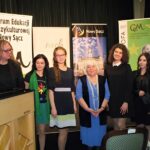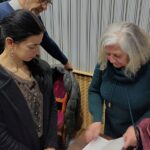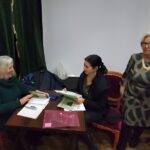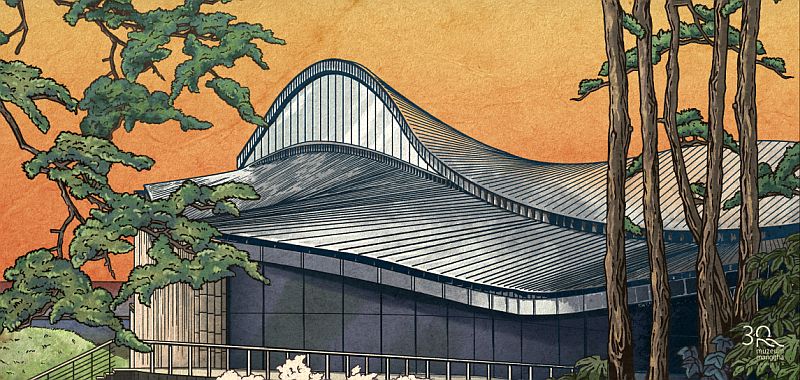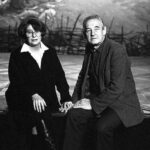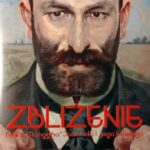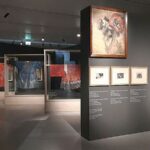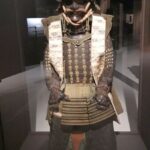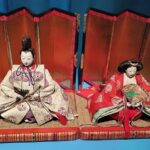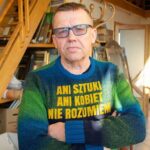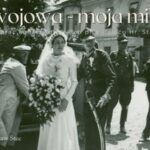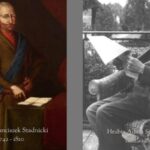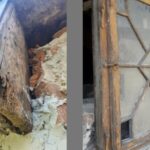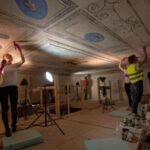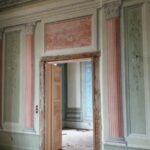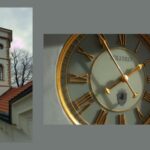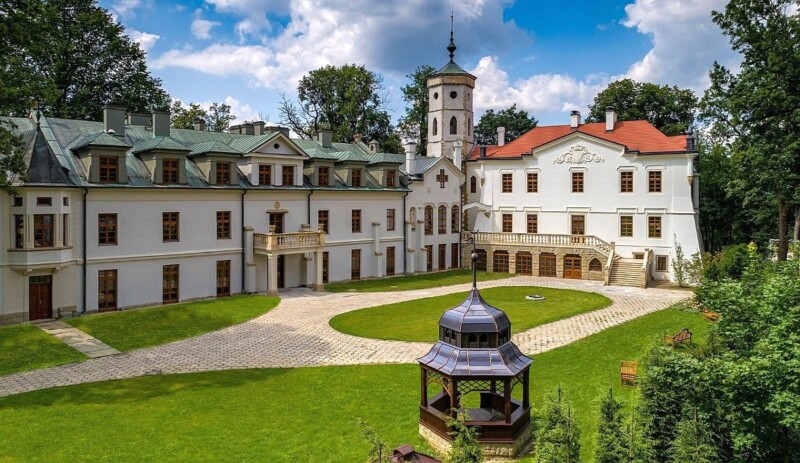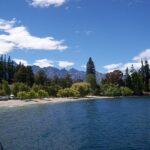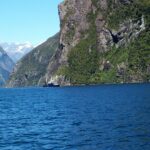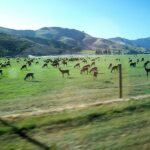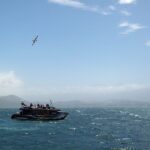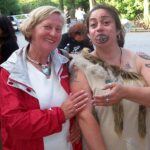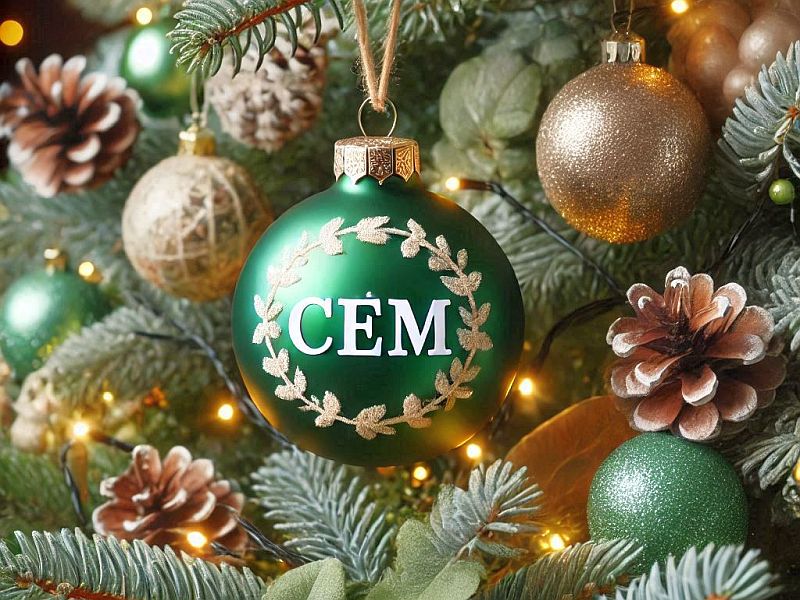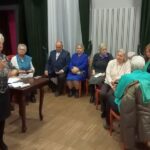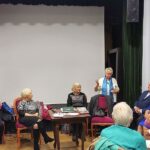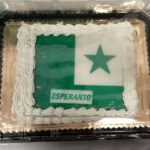From April 7th to 11th, 2025, a group of 20 of our members went on a trip to Toruń. The aim, apart from meeting with Esperantists, was to explore one of the most beautiful cities rich in historical monuments. The train journey from Kraków to Toruń was quick and comfortable. From the station, we efficiently took taxis to the B&B Hotel, located in the very center of the city.
The next day, after a delicious breakfast, we started implementing a very rich and interesting program of city exploration. We saw the Old Town Square, the Town Hall, the Copernicus Monument, the “House Under the Star,” the Artus Court which included a gingerbread shop inside the Flisak Fountain, the Church of the Holy Spirit, the Main Post Office and the Church of the Virgin Mary. For each location, we listened to a brief history and interesting anecdotes associated with it.
In the Museum of Gingerbread, besides exploring the exhibits with a guide and tasting gingerbread, we participated in workshops making decorative gingerbread.
In the afternoon, we visited the Leaning Tower, the Gothic Granary, the Baroque Granary, the Monastic Gate, the Pigeon Gate, the Sailor’s Gate, the Cathedral of St. John, the Bridge Gate, the Bourgeois Court, the Guard Tower with a residence, and the ruins of the Teutonic Castle surrounded by historic townhouses.


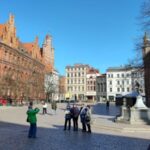
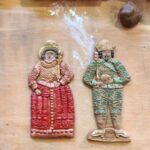
In the evening, we participated in one of the most famous and revolutionary stage works of the 20th century – “Jesus Christ Superstar.” The Toruń adaptation was created in the form of immersive theater where the boundary between stage and audience is blurred, and viewers are actively engaged in the performance. The venue for the performance was the concert hall of the iconic Toruń music club “Od Nowa.” The performance left an extraordinary impression on us.

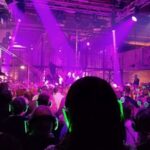


The next day, we climbed the observation tower of the Old Town Hall, which offers a beautiful panorama of the city. We also saw exhibitions dedicated to the history of Toruń. Then, we visited the Ethnographic Museum with its open-air section in the city center, guided by Ms. Maria – an Esperantist and a long-time employee of the museum with extensive knowledge of the exhibits and their history. In the afternoon, we individually explored selected places and attractions in the city.
In the evening, we had an interesting meeting with an Esperantist from Toruń, during which we exchanged fascinating information about the activities of both clubs.



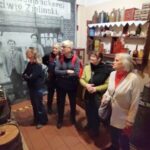
On the third day, we visited: the Copernicus Museum, the Museum of the History of Toruń, the “Invisible House” – for the brave and then strolled across the Piłsudski Bridge to the other side of the Vistula River to the observation tower and the ruins of the Dybów Castle.


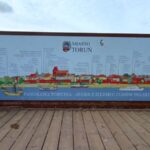

On the last day, we individually walked around the old Toruń, reminiscing about the pleasant and interesting moments. Despite the very rich program of the trip, everyone found time to relax with a meal and do some individual sightseeing. Full of unforgettable experiences, we returned by train to Kraków. We will remember this well-organized and fascinating trip for a long time.
Barbara Połomska
The latest club meeting of the Center for Intercultural Education Association this year took place on March 3, 2025. The main theme of the meeting was Esperanto. The choice of this topic was prompted by the anniversary of the passing of Halina Komar, the founder of our association, as well as the completion of Esperanto studies and the defense of a diploma thesis by Lidia Helena Komar at the Interlinguistic Studies program at Adam Mickiewicz University in Poznań.
During the meeting, we reminisced about Halina and had a conversation with Lidia, who is the granddaughter of the late Halina Komar.

Lidia’s interest in the Esperanto language and its ideals was inspired by her grandmother Halina’s dedication. She participated in many events and initiatives organized by Halina. She became fluent in Esperanto and completed the methodological training program “Instruista Trejnado” as part of the international “Erasmus+” project.
Along with other participants of the interlinguistic studies program (who came from the United Kingdom, the Czech Republic, China, France, and Poland), Lidia took a comprehensive exam in September 2024. The exam covered Esperanto language skills, Esperanto culture, and the history of the Esperanto movement. Additionally, an integral part of the exam involved teaching a self-prepared Esperanto lesson before an examination committee.
The supervisor for diploma theses in the field of methodology was Katalin Kovats, a Hungarian educator living in the Netherlands, a distinguished expert in Esperanto education, the founder of the Edukado.net portal, and the director of examinations at the Universal Esperanto Association (UEA). Lidia wrote her thesis titled “Halina Komar kaj ŝia socia agado” (“Halina Komar and Her Social Activities Through Esperanto”). The topic was suggested by Katalin Kovats, who knew Halina Komar well and had attended several of our events in Nowy Sącz.
The thesis was reviewed by Barbara Pietrzak, a well-known promoter of Esperanto, a Polish Esperantist, and a radio journalist who runs Pola Ret Radio. In previous years, she was a board member of the UEA and is a member of the Akademio de Esperanto. Until 2024, the director of the External Postgraduate Interlinguistic Studies and the Department of Ugro-Finnic Philology at Adam Mickiewicz University was Professor Ilona Koutny, a Hungarian linguist residing in Poland.
Unfortunately, 2024 brought unfavorable developments for Esperanto in our country. After 26 years, the Esperanto Interlinguistic Studies program at Adam Mickiewicz University in Poznań was discontinued, and the Esperanto culture festival “Arkones” was held for the last time.
We sincerely thank Lidia for her participation in the meeting and wish her success in using her Esperanto language skills and teaching qualifications for the benefit of the Esperanto movement.
Transl. Admin+AI
On February 12, representatives of the Center for Intercultural Education took part in a bus trip to the Wieliczka Salt Mine. Our guide was Magda Tatara, a professional salt mine guide who speaks French and Esperanto.
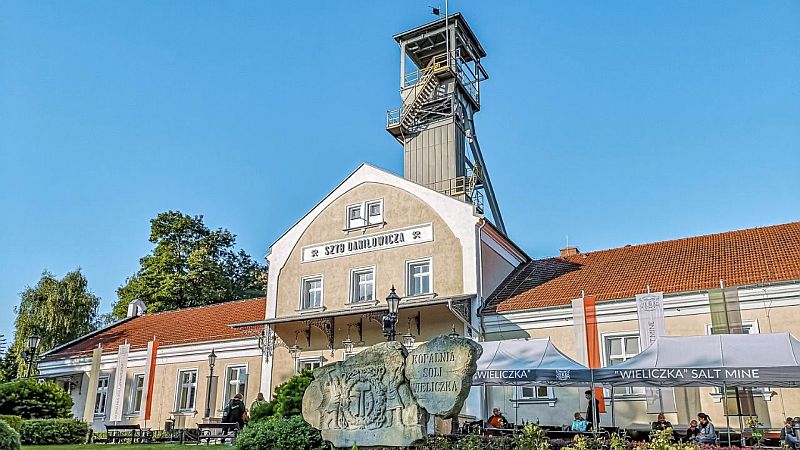



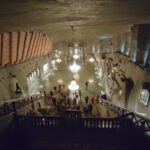
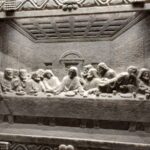


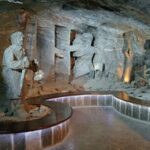

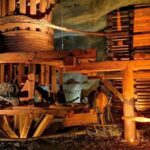
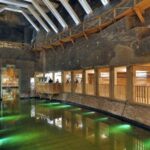

After an amazing experience exploring the world-famous museum, we headed to Manggha – the Museum of Japanese Art and Technology in Kraków, where we visited three exhibitions. For some of us, it was the first time seeing the Center.
Both places are significant and valuable cultural landmarks in our region.
On February 3rd, during the second meeting of our Association this year, we had the honor of hosting a remarkable guest—artist, conservator, and restorer of artworks, Józef Stanisław Stec.
He is a well-known artist in Nowy Sącz and the owner of ARStec Art and Conservation Studio, founded in 2007. The Studio specializes in the comprehensive conservation of architectural monuments, artworks, and objects of artistic craftsmanship.
Since 1992, he has lived and worked creatively in Nowy Sącz. A member of the Association of Polish Artists and Designers (ZPAP) since 1989, he adheres to the principle of “the law of good continuity” in life and art. In recognition of his contributions to Polish culture, the Minister of Culture, National Heritage, and Sport, Prof. Piotr Gliński, awarded him the Bronze Medal for Merit to Culture – Gloria Artis.
During the meeting, we had the pleasure of attending a lecture titled “Nawojowa – My Love: Notes on Conservation Work at the Stadnicki Palace.” The speaker shared his experiences regarding the restoration of the palace’s facade:
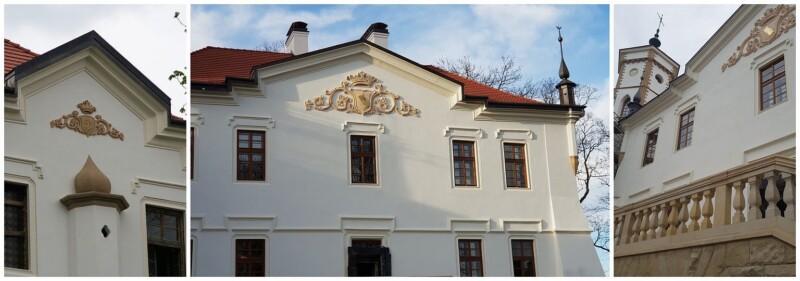
and interiors in Nawojowa:
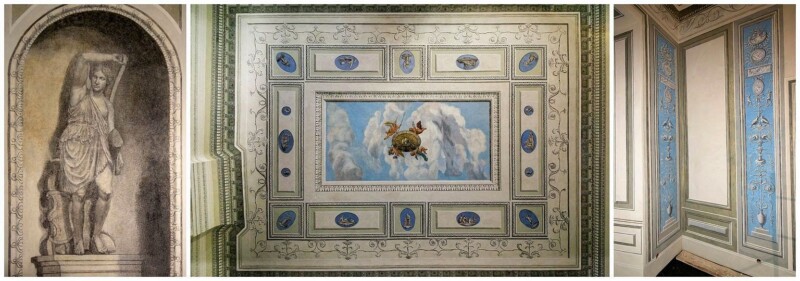
Anyone who has been to or passed through Nawojowa remembers that the palace was once a crumbling and neglected ruin.
In 2013, Krzysztof Mańkowski, a descendant of Count Adam Stadnicki, stated:
“We have a lot of work ahead of us. We want to serve the entire community so that Nawojowa, as in my great-grandfather’s time, once again becomes an important place for the region. It’s not as simple as regaining the palace today and moving in tomorrow. This will take time. A detailed project is necessary because the building has historical value and is under conservation protection. Step by step, we will restore it.”
In 2014, the Minister of Agriculture and Rural Development decided to return the Nawojowa Palace and Park Complex to the descendants of Count Adam Stadnicki. The then-mayor of Nowy Sącz, Jan Golonka, signed the document officially transferring possession of the palace to Andrzej Mańkowski, the heir.
A special company was established to develop a revitalization plan. Its main goal, in line with the owners’ intentions, was to transform the palace into a House of Creative Work, where cultural and scientific activities could flourish.
The project also envisions the creation of a conference, scientific, and business center, as well as a hotel, conference hall, restaurant, and tea house. The park will also be restored, bringing back the design of an English garden originally planned by Edward Stadnicki in the 1840s, which still features old oaks, plane trees, thujas, and cypress trees.
The palace renovation began in 2019, with the Nowy Sącz-based company Erbet carrying out the work. The conservation tasks were entrusted to Józef Stanisław Stec’s company. The building’s facade has been restored, and intensive reconstruction work has been ongoing inside. A clock was installed in the tower, and its interior saw the renovation of historic bricks and numerous polychrome paintings. The window and door woodwork has been reconstructed, and in the oldest wing of the palace, the staircase renovation is underway.
During the lecture, through dozens of photographs, we followed the stages of monument conservation, from its dilapidated state before work began to the remarkable restoration of its facade and interiors, thanks to the conservation expertise of Józef Stanisław Stec and his team.
The main phase of the work has been completed, and its continuation will depend on future commissions from the palace owners. Meanwhile, we were presented with visualizations of the interior finishes, showcasing beautifully designed woodwork. We wish the owners success in restoring the palace to its former glory as soon as possible.
AI, Admin J.S.
On January 13, 2025, the first club meeting of the year took place for the members of the Center for Intercultural Education in Nowy Sącz. The program of the meeting was rich and diverse:
Our friend, Maria Baran, took us on a virtual trip to New Zealand. She presented reports from her “Trip of a Lifetime” – as she called it – to Australia and from there with her daughter to New Zealand.
We had the opportunity to discover the beauty, richness, and diverse landscapes, as well as the culture of this exotic country for us – the Land of the Long White Cloud, located in the Pacific. This country is the farthest from Poland (over 17,000 km), and it is only 1,600 km away from Australia.
She showed us beautiful cities on the South Island – Christchurch, Queenstown, Kaikoura, as well as the stunning lakes Wakatipu, Te Anau and the Milford Sound waterway, from where panoramic mountain views with numerous waterfalls could be seen. The South Island is home to the Southern Alps – the highest peak, Mount Cook (3754 m above sea level), and the Tasman Glacier (29 km).
Beautiful photos on the big screen allowed us to admire these charming landscapes where Maria walked and took photographs. She observed seals lounging on rocks, water flowing from waterfalls, and herds of sheep and deer. In her frames, she also recorded endemic species such as kiwi, kangaroos…, as well as encounters with the people and culture of the Māori. The rich photographic documentation and Maria’s memories transported us to these wonderful climates. Maria also talked about the development of the Esperanto language in Australia and New Zealand.
The Christmas season is a time for singing carols. The Christmas carols prepared by the Esperanto group of our friend Jola Kieres, accompanied by Alicja Skalska, sounded beautifully. They were sung by everyone in both Esperanto and Polish, thanks to the technical support provided by Jarek Szewczyk.
Organizational matters were also discussed, regarding planned educational and cultural trips to Wieliczka and Kraków, as well as Toruń, by invitation from local Esperantists.
At the end of the meeting, those traveling to Brno, Czech Republic, for the World Esperanto Congress were informed about the program and travel details.
Krystyna Słaby
On December 9, 2024, at 3:00 PM, members of the Center for Intercultural Education gathered for a celebration marking the 165th anniversary of the birth of Ludwik Zamenhof, known as “Zamenhof Tago.”
Event Program:
1. Welcome and Updates presented by Bożena Kocyk in Esperanto with translation provided by Jolanta Kieres.
2. “Appearance” by Ludwik Zamenhof and His Daughter Lidia Zamenhof. A presentation on screen, developed using artificial intelligence by our expert and enthusiast of modern technologies, Jarosław Szewczyk.
3. Esperanto Anthem – performed by all attendees, accompanied on accordion by Alicja Skalska (lyrics were displayed on the screen).
4. Esperantists in a Cheerful Mood – organized by Jolanta Kieres.
Participants of the Tuesday Esperanto course recited 10 stanzas of Julio Baghy’s poem “Estas mi Esperantisto.” Subsequently, participants of the Thursday Esperanto course presented short poems by Roman Dobrzyński: Perfekta kaj Difekta, Saĝo post Damago, Belulo, Fremdaj kaj Propraj, Libereco, Potenco de Entuziasmo from the collection Verda Simio.
5. Maria Baran talked with Krystyna Dulak-Kulej, a poet, Esperantist, and traveler. The conversation included casual life anecdotes, coincidences, and spontaneous decisions that led to relocations and fascinating journeys.
6. Singing Esperanto Songs accompanied by accordion.
7. The event concluded with a tasting of Zamenhof cake and with informal discussions.
The highlights of the celebration were noted in brief by:
Ewa Merha
On November 4, 2024 a club meeting of the members of the Center of Multicultural Education (CEM) took place. November, as the month marking the anniversary of Poland’s regained independence after 123 years of partition, was an appropriate time to organize a meeting focused on this important occasion.
At the beginning of the meeting, CEM President Bożena Kocyk thanked the participants of the project “Knowledge of Foreign Languages Widens Horizons” for their dedication and fruitful collaboration. The final project report was approved in full, which enabled the National Agency to transfer the final payment, amounting to 20% of the project’s total value, to the association’s account.
Later in the meeting, we listened to an introductory speech and watched a film prepared by our colleague Jarosław Szewczyk about Bronisław Piłsudski, the brother of Józef Piłsudski. Bronisław was an exile and an ethnographer who studied the peoples and cultures of the Far East, particularly the Ainu people. He was sentenced to death for his involvement in an assassination attempt on Tsar Alexander III, but his sentence was later commuted to exile and forced labor on Sakhalin Island. He married a relative of an Ainu chief relative, with whom he had two children.
Japanese Esperantist Teruo Matsumoto, who lived in Poland, was also interested in the life of Bronisław Piłsudski. He appeared in the film, and as Vice President of the Polish Esperanto Association, Matsumoto often spoke about Bronisław at Esperanto meetings.
The meeting concluded with a group singing of patriotic songs accompanied by our colleague Alicja Skalska on the accordion.
Bożena Kocyk
In accordance with statutory requirements and regulations concerning the activities of non-governmental organizations, on 07.10.2024, the General Assembly of CEM Members took place, during which the authorities were elected for the next 3-year term, and work plans for the upcoming year were presented. The composition of the board remains unchanged. The names of the members are listed on the CEM website.
A new person, Ewa Merha, joined the Audit Committee. Alicja Skalska was re-elected as Chairperson, and Zofia Homoncik as a member. As part of the statutory activities, Esperanto and English classes will continue, along with monthly club meetings, where we will invite interesting guests, or our members will present their own presentations.
Information was provided about an exhibition planned for 2025 by the Sądecka Land Museum in cooperation with CEM, which will be held in the Galician Town and will be dedicated to Esperanto. As part of the language and tourism trips, a trip to Toruń is planned, where we will meet with local Esperantists, and also a trip to the International Esperanto Congress in Brno, Czech Republic, in July 2025.
We encourage everyone to actively participate in the activities of our association.
Bożena Kocyk

